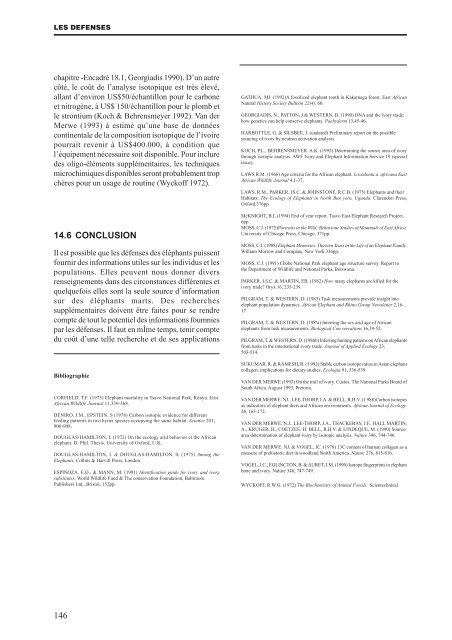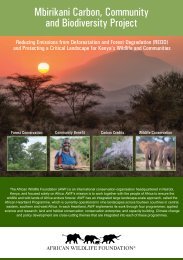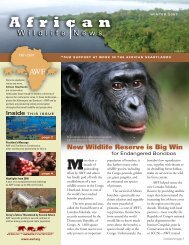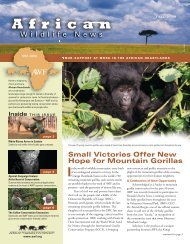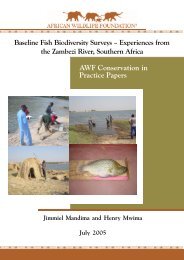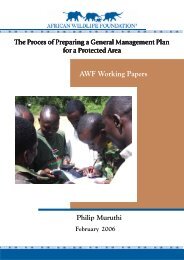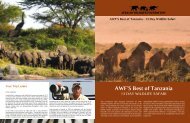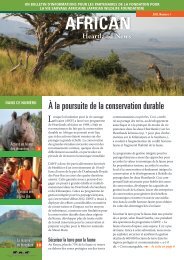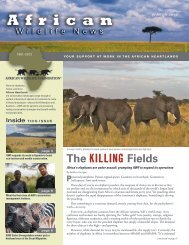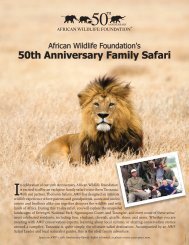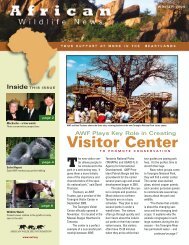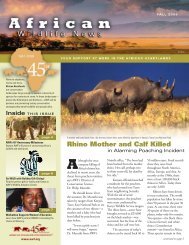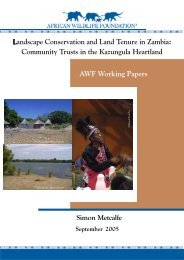1er CHAPITRE - African Wildlife Foundation
1er CHAPITRE - African Wildlife Foundation
1er CHAPITRE - African Wildlife Foundation
You also want an ePaper? Increase the reach of your titles
YUMPU automatically turns print PDFs into web optimized ePapers that Google loves.
LES DEFENSES<br />
chapitre -Encadré 18.1, Georgiadis 1990). D’un autre<br />
côté, le coût de l’analyse isotopique est très élevé,<br />
allant d’environ US$50/échantillon pour le carbone<br />
et nitrogène, à US$ 150/échantillon pour le plomb et<br />
le strontium (Koch & Behrensmeyer 1992). Van der<br />
Merwe (1993) à estimé qu’une base de données<br />
continentale de la composition isotopique de l’ivoire<br />
pourrait revenir à US$400.000, à condition que<br />
l’équipement nécessaire soit disponible. Pour inclure<br />
des oligo-éléments supplémentaires, les techniques<br />
microchimiques disponibles seront probablement trop<br />
chères pour un usage de routine (Wyckoff 1972).<br />
14.6 CONCLUSION<br />
Il est possible que les défenses des éléphants puissent<br />
fournir des informations utiles sur les individus et les<br />
populations. Elles peuvent nous donner divers<br />
renseignements dans des circonstances différentes et<br />
quelquefois elles sont la seule source d’information<br />
sur des éléphants marts. Des recherches<br />
supplémentaires doivent être faites pour se rendre<br />
compte de tout le potentiel des informations foumnies<br />
par les défenses. Il faut en mÍme temps, tenir compte<br />
du coût d’une telle recherche et de ses applications<br />
Bibliographie<br />
CORFIELD, T.F. (1973) Elephant mortality m Tsavo National Park, Kenya. East<br />
<strong>African</strong> <strong>Wildlife</strong> Journal 11,339-368.<br />
DENIRO, J.M., EPSTEIN, S (1978) Carbon isotopic evidence for different<br />
feeding patterns in two hyrax species occupying the same habitat. Science 201,<br />
906-908.<br />
DOUGLAS-HAMILTON, I. (1972) On the ecology arid behavior et the <strong>African</strong><br />
elephant. D. Phil. Thesis. University of Oxford, U.K.<br />
DOUGLAS-HAMILTON, I. & DOUGLAS-HAMILTON, 0. (1975) Among the<br />
Elephants. Collins & Harvill Press, London.<br />
ESPINOZA, E.O., & MANN, M. (1991) Identification guide for ivory and ivory<br />
substitutes. World <strong>Wildlife</strong> Fund & The conservation <strong>Foundation</strong>, Baltimore.<br />
Publishers Ltd., Bristol, 152pp.<br />
GATHUA. MJ. (1992)A fossilized elephant tooth in Kakamega forest. East <strong>African</strong><br />
Natural History Society Bulletin 22(4), 60.<br />
GEORGIADIS, N., PATTON, J.& WESTERN, D. (1990) DNA and the ivory trade:<br />
how genetics can help conserve elephants. Pachyderm 13,45-46.<br />
HARBOTTLE, G. & SILSBEE, J. (undated) Preliminary report on the possible<br />
sourcing of ivory by neutron activation analysis.<br />
KOCH, P.L., BEHRENSMEYER. A.K. (1992) Determining the source area of ivory<br />
through isotopic analysis. AWF Ivory and Elephant Inforimation Service 19 (special<br />
issue).<br />
LAWS R.M. (1966) Age criteria for the <strong>African</strong> elephant. Loxodonta a. africana East<br />
<strong>African</strong> WildIife Journal 4,1-37.<br />
LAWS, R.M., PARKER. JS.C. & JOHNSTONE, R.C.B. (1975) Elephants and their<br />
Habitats: The Ecology of Elephants in North Bun yoro, Uganda. Clarendon Press,<br />
Oxford.376pp.<br />
McKNIGHT, B.L (1994) End of year report. Tsavo East Elephant Research Project.<br />
6pp.<br />
MOSS, C.J. (1975)Portraits in the Wild: Behaviour Studies of Mammals of East Africa.<br />
University of Chicago Press, Chicago. 371pp.<br />
MOSS, C.J. (1988) Elephant Memories. Thirteen Years in the Life of an Elephant Family.<br />
William Morrow and Company, New York 336pp.<br />
MOSS, C.J. (1991) Chobe National Park elephant age structure survey. Report to<br />
the Department of <strong>Wildlife</strong> and National Parka, Botswana.<br />
PARKER. I.S.C. & MARTIN, EB. (1982) How many elephants are killed for the<br />
ivory trade Oryx 16, 235-239.<br />
PILGRAM, T. & WESTERN, D. (1983) Tusk measurements provide insight into<br />
elephant population dynamics. <strong>African</strong> Elephant and Rhino Group Newsletter 2,16- .<br />
17.<br />
PILGRAM, T. & WESTERN, D. (198 6 a) Interring the sex arid age of Atrican<br />
elephants from tusk measurements. Biological Con servations 36,39-52.<br />
PILGRAM, T. & WESTERN, D. (1986b) Inferring hunting pattems on <strong>African</strong> elephants<br />
from tusks in the intemational ivory trade. Journal of Applied Ecology 23,<br />
503-514.<br />
SUKUMAR. R. & RAMESH, R. (1 992) Stable carbon isotope ratios in Asian elephant<br />
collagen: implications for dietary studies. Ecologia 91, 536-539.<br />
VAN DER MERWE (1993) On the trail of ivory. Custos. The National Parks Board of<br />
South Africa. August 1993, Pretoria.<br />
VAN DER MERWE. NJ., LEE-THORP, J.A. & BELL, R.H.V. (1 988)Carbon isotopes<br />
as indicators of elephant diets and <strong>African</strong> environments. <strong>African</strong> Journal of Ecology<br />
26, 163-172.<br />
VAN DER MERWE. N.J., LEE-THORP, J.A., THACKERAY, J.F., HALL MARTIN,<br />
A., KRUGER, H., COETZEE. H. BELL, R.H.V. & LINDEQUE, M. (1990) Sourcearea<br />
determination of elephant ivory by isotopic analysis. Nature 346, 744-746.<br />
VAN DER MERWE. NJ. & VOGEL, JC. (1978) 13C content of human collagen as a<br />
measure of prehistoric diet in woodland North America. Nature 276, 815-816.<br />
VOGEL, J.C., EGLINCTON, B. & AURET, J.M. (1990) Isotope fingerprints in elephant<br />
bone and ivory. Nature 346, 747-749.<br />
WYCKOFF, R.W.G. (1972) The Biochemistry of Animal Fossils. Scientechnical<br />
146


